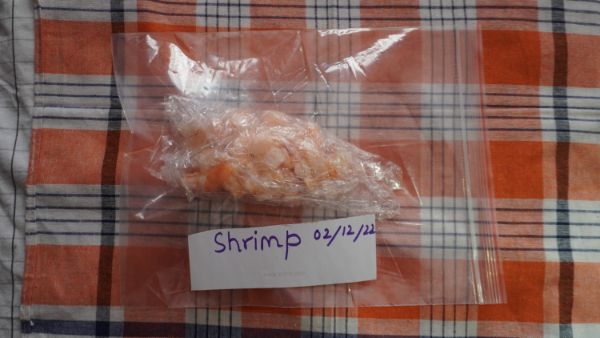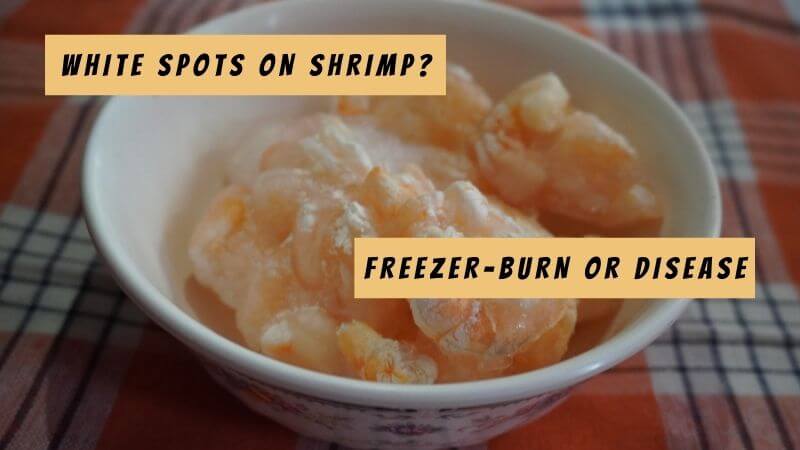I recently started going to the gym, so I have been watching what I eat. I’m on a strict diet, and the shrimps tossed in the back of the freezer were just chilling for I don’t know how long.
I have a ‘cheat day’ on Saturdays – I can eat anything I like. Calorie overload. So, one fine Saturday, I decided to make garlic shrimp and jasmine rice for lunch.
I take out the shrimp from the freezer and put them on a plate to clean and prepare them when I notice tiny spots dotted all over them! As someone who keeps fish and inverts, I knew instantly the white dots didn’t bode well.
Was it the white spot disease? Perhaps something more sinister? Or is it just a freezer burn? I had so many questions!
Keep reading to know!
Table Of Content
What Are The White Spots On Shrimps?
The white spots on shrimps are either from a freezer burn or white spot disease. In both cases, the shrimp in question is safe to eat. If you are finicky, you can get rid of the parts with white spots and save the rest. But I cooked the shrimp whole, and they turned out perfectly fine.
To be honest, I don’t know for sure if my shrimps had just freezer burned or were diseased. But from my research, I knew that they were safe to eat. So, I had no qualms about cooking and eating them.
Having said that, if I had to make a guess, I would say my shrimp probably had the white spot disease. Their taste and texture would have been severely compromised if they were freezer-burned.
You May Also Like:
Why Are Anchovies So Salty? How Salt Can Harm You?
How To Store Cut Celery? Use This Nifty Hack!
How To Store Red Chilies In The Fridge? Picture And Video Guide
White Spots On Shrimp Due To Freezer Burn
Freezer burn happens due to moisture loss. Any food left frozen for too long will eventually get freezer burn. In most cases, freezer-burned food is covered in ice crystals, which gives it the appearance of being dotted with white spots.
Besides that, the shrimp will look leathery and shriveled.
While all foods can develop freezer burn, foods with high moisture content are the most susceptible. The water present in the shrimp will turn into tiny ice crystals before moving to its surface.
These crystals eventually migrate to the coldest section of the freezer. This process is called sublimation. The substance changes directly from a solid state to a gas during sublimation.
Remember how ice cubes become small over time?
Getting back to the topic, the water loss leads to dehydration, making the food dry and shriveled.
Will Freezer Burn Affect Taste And Texture?
If your shrimps have freezer burn, you’ll most likely notice a shift in texture and flavor that makes the food less appealing. The shrimp will turn unusually dry and bland and be chewy due to moisture loss.
Unfortunately, it’s not possible to reverse freezer burn. You can only minimize the impact by masking the taste and cutting off the affected parts.
Is It Safe To Eat Freezer-Burned Shrimp?
Freezer-burned shrimp is unappetizing but perfectly safe to eat. There’s no health hazard from eating freezer-burned shrimp. However, I’d recommend using a recipe that calls for sauces and broths so that some of the moisture is restored.
How To Cook Freezer-Burned Shrimps?

Since freezer burn will have seriously impacted the shrimp’s taste and texture, I recommend making shrimp curry since curries incorporate several strong spices and restore the lost moisture.
For this recipe, I will teach you how to make Indian-style shrimp curry featuring coconut milk and aromatic spices. You can prepare this dish in just 30 minutes.
Let’s have a look at the ingredients first!
- Shrimps
- Ginger
- Garlic
- Coconut Milk
- Tomato puree
- Peas
- Chili pepper
- Bell Pepper
- Garam Masala
- Cumin powder
- Coriander powder
- Ground turmeric
- Salt
- Oil
Instructions:
The first step is to marinade the shrimp. Transfer the shrimp to a big bowl and add all the spices and some oil. Mix properly and set aside.
Next, chop bell pepper and chili pepper. Also, mince garlic and ginger.
Heat some oil in a pan and sear the shrimp on both sides. Once they are cooked and turn golden brown, remove them from the heat and set them aside.
In the same pan, heat up some oil once again. Add the veggies, minced ginger, and minced garlic, and saute everything. Then add some coconut milk and let it simmer.
Once the veggies are cooked, add shrimp and salt, and garnish with coriander. Let it simmer for 2 minutes more, and turn off the heat.
The shrimp curry was delectable! The ruined texture and taste were somewhat salvaged, thanks to good old aromatic spices. By the time the dish was done, I was so hungry that I completely forgot to take pictures.
If you’re not big on curries, you can make one of the following dishes:
- Pesto shrimp
- Shrimp pasta
- Shrimp scampi
- Shrimp cakes
- Soup or chowder
- Shrimp fried rice
Now, I’ll quickly tell you how to correctly store shrimp to avoid freezer burn before moving on to our next section, where we will discuss the white spot disease.
How To Store Shrimp To Avoid Freezer Burn?

If stored correctly, frozen shrimp can last in mint condition for several months. The store packaging is often inadequate to offer complete protection. So, you will need to pack the shrimp safely once again.
First, wrap shrimp in plastic wrap or simply leave the store packaging on. Next, place the shrimp into another airtight container or a heavy-duty freezer bag, so there’s a dual layer of protection.
Lastly, remember to label it with a date. You can now safely store shrimp in the freezer for up to 6 months!
Now, let’s quickly discuss the white spot disease in shrimps and what it means for humans.
White Spots On Shrimp Due To White Spot Disease
Another probable reason behind white spots in your frozen shrimp is well the white spot disease. This condition is caused by a large DNA virus assigned as the one and only member of the genus Whispovirus. This virus only affects crustaceans.
The baneful virus can be found in fresh, marine, or brackish water. This disease has mainly been a problem in farmed prawns, and unfortunately, there’s no known treatment for this.
Shrimps that have contracted this virus mostly don’t even make it to the market. They die quickly. And as far as I know, selling already dead shrimp is not really a thing.
Thankfully for us, it’s completely safe to eat any shrimp ridden with white spot disease since the virus in question can have no effect on humans.
The More You Know!
Before we end this article, here’s a quick look at some of the most frequently asked questions on white spots on shrimps.
How Do You Prevent White Spots On Prawns?
As we discussed above, white spot disease could be caused due to freezer burn or white spot disease. In the first case, you can prevent the white spots from forming by correctly storing the shrimp and consuming it on time.
However, in the second case, there’s nothing you can do about the white spots. They were probably there when you first bought the prawns. But the good news is that you can still eat shrimps with this disease. They cannot affect humans.
Is It Safe To Eat Shrimp With Freezer Burn?
Yes, it’s entirely safe to eat shrimp with freezer burn. As a matter of fact, you can eat any food that has freezer burn.
Having said that, the shrimp’s texture and flavors will be quite profusely compromised due to freezer burn. You’ll need to go the extra mile to mask the freezer-burn taste and restore the moisture.
And honestly, that’s not always worth it.
How Can You Tell If Refrigerated Shrimp Is Bad?
If the shrimp looks moldy, squishy, or slimy, it probably has gone bad. It will also give off a strong, off-putting smell.
Final Words: White Spots On Shrimps
So, we have finally come to the end of this long article! Let me quickly recap the most important bits here.
White spots on shrimps are either due to freezer burn or white spot disease. In both cases, it is entirely safe to eat the shrimp.
However, if the spots are due to freezer burn, the texture and flavor will be ruined, and you’d have to work hard to salvage the dish.
Keep Reading!
Can You Use Powdered Sugar In Tea? My Little Experiment!
How Long Do Grapes Last In The Fridge? How To Correctly Store Grapes?
